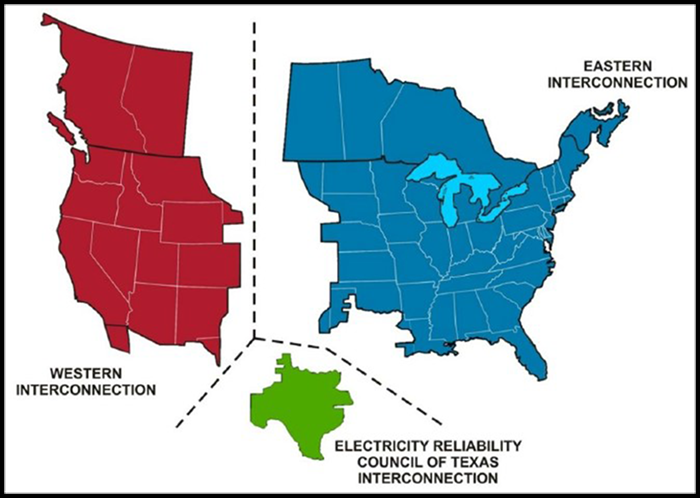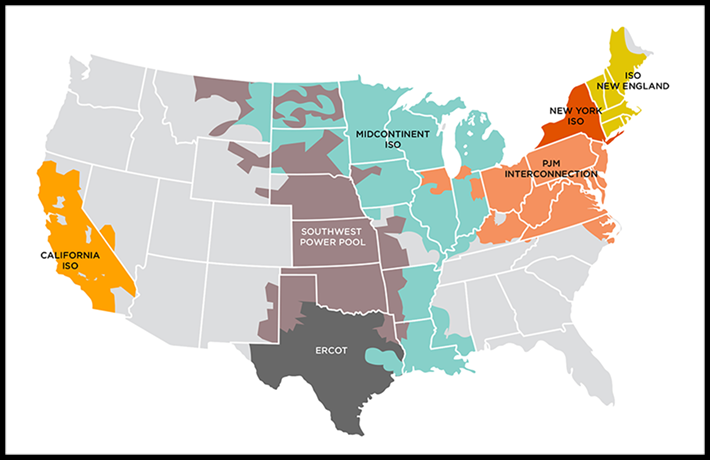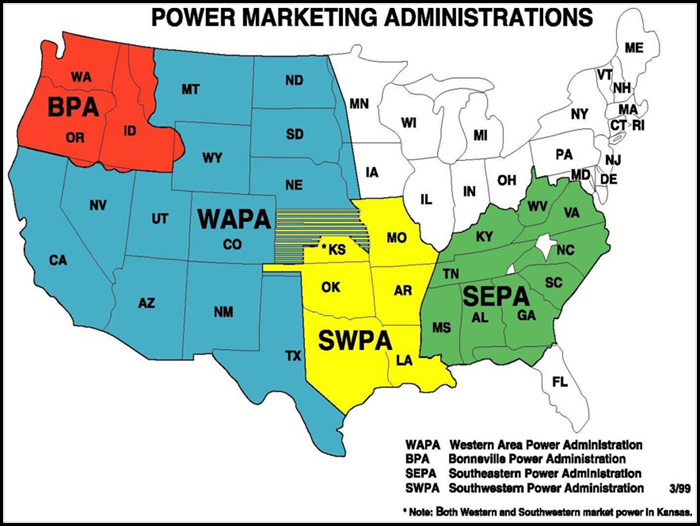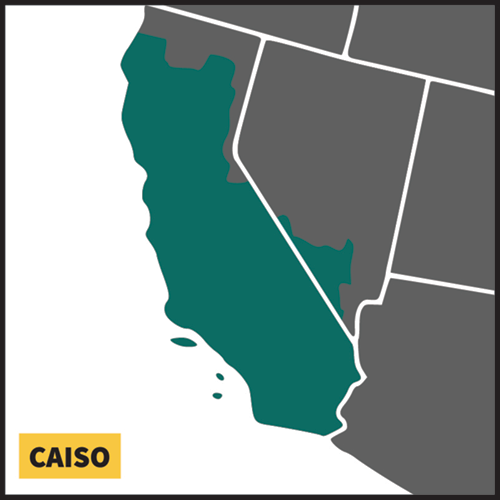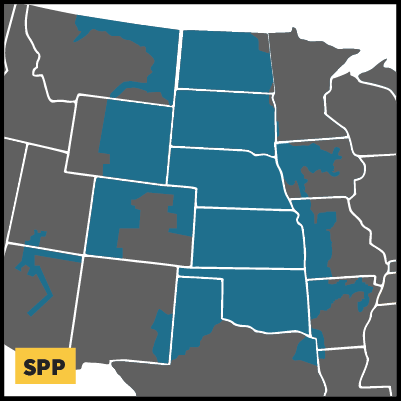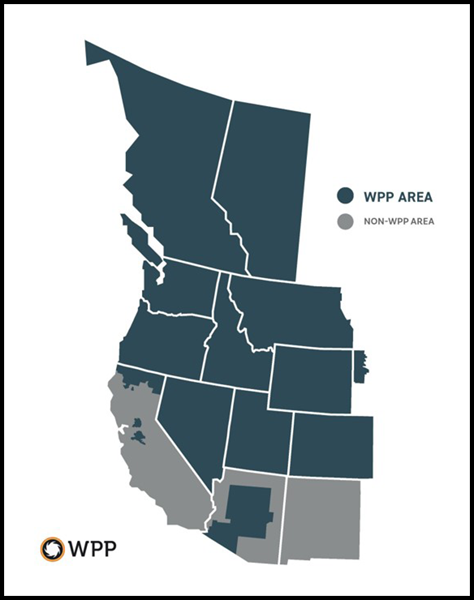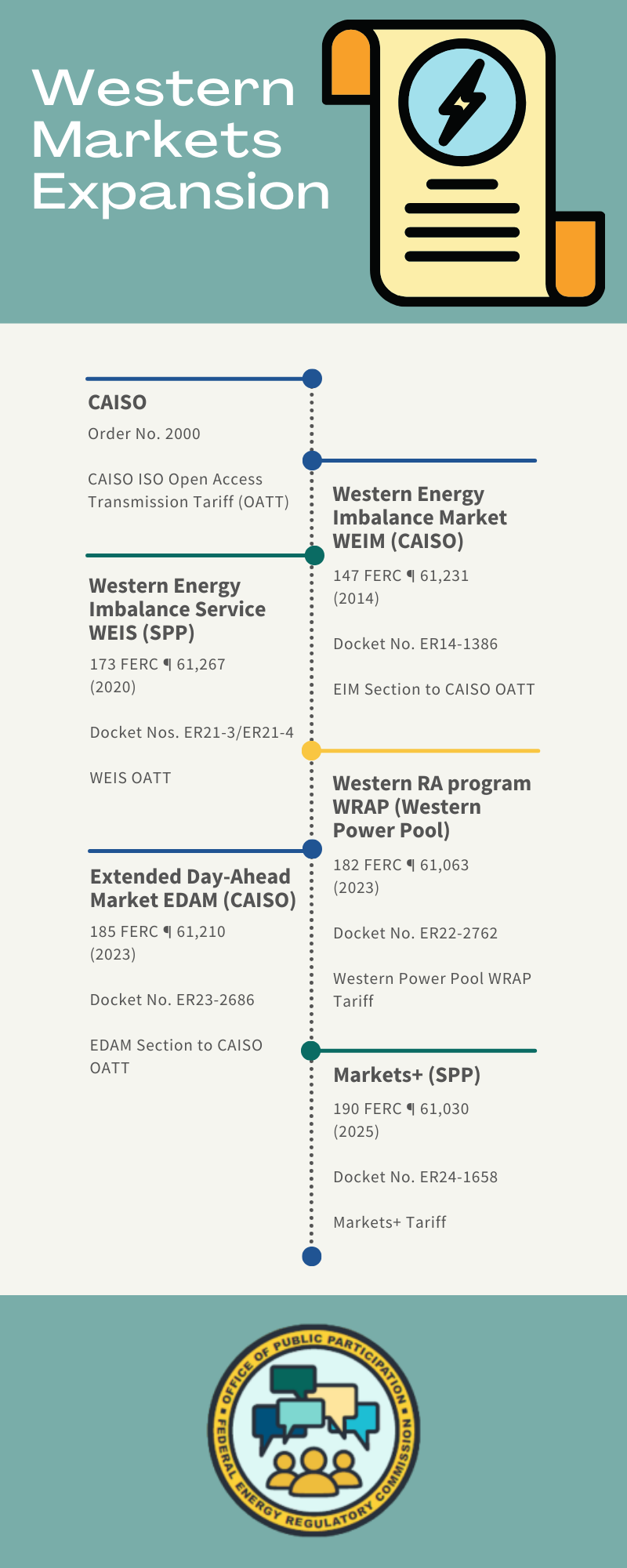This explainer offers a comprehensive overview of the electricity markets in the Western United States. It covers key features of the markets that enable coordinated and efficient management of the region’s electric transmission grid system. This explainer will help you understand how new developments in electricity markets in the West may impact energy costs, system reliability, and the implementation and achievement of state-level energy policies.
This explainer is organized with four major sections:
- Key Terms
- Introduction to the U.S. Power Grid and FERC-led Initiatives to Create Wholesale Markets
- Overview of Electricity Markets in the West
- Resources to Learn More about Western Market Matters at FERC
This explainer offers a summary of publicly available information about Western markets and should not be relied upon as a legal document.
Key Terms
Balancing Authorities oversee electricity transfers and ensure grid stability by maintaining a balance between the production and consumption of electricity. They typically oversee long-term efforts to maintain that key balance on the grid, such as resource planning, as well as short-term balancing by committing electricity supply resources to operate and real-time load-frequency control within a balancing authority area. Certain electric utilities and power marketing administrations (see below) are typical examples of balancing authorities.
A Balancing Authority Area is a geographic region that incorporates a collection of generation facilities, transmission lines, and loads (aggregated consumer demand for electricity) where electric metering is performed by a balancing authority. The responsibility of maintaining a balance between the load and resources (supply of electricity) within this area falls under the jurisdiction of the balancing authority. One example of a balancing authority area is a utility service territory.
Congestion occurs when a portion of the transmission grid becomes overloaded with electricity. Congestion can occur when a line or transformer reaches its limit and cannot carry any more electricity. When congestion occurs, the lowest-priced electricity cannot flow freely to a specific area.
Congestion Revenue Rights are financial tools used to manage the cost variability of congestion on the grid based on the electricity pricing approach used, called locational marginal pricing (see below). Such rights are often acquired to hedge against congestion costs in the day-ahead market, but sometimes are purchased as an investment.
A Day-Ahead Market is a voluntary financial market where individuals and companies can buy and sell wholesale electric energy at financially binding prices for the next day.
Hedging is the act of engaging in transactions to reduce risk from price volatility (see below) for a company and/or customers. Hedging transactions can help electricity suppliers meet their customers’ demands while reducing or eliminating the risk of fluctuating prices.
Locational Marginal Pricing or Prices (LMP) refer, respectively, to the overall pricing scheme or the actual prices paid for wholesale electric energy at a specific location within an electric transmission grid at a specific point in time. LMP data is used to track the prices of electricity in different parts of the grid and to help manage supply and demand for electricity.
Price Volatility describes how quickly or widely prices can change. In the energy industry, price volatility can refer to electricity or natural gas supply prices, relative to consumer demand. Volatility is measured by the day-to-day variation (percentage difference) in the price of the commodity.
A Power Marketing Administration is a federal agency within the Department of Energy that markets electric power produced by federal dams and multiple-purpose water projects providing service to customers.
A Real-Time Energy Market is a spot market that allows consumers, companies, and energy distribution businesses to buy and sell wholesale electric energy in real-time, usually an hour before delivery. The real-time market balances the differences between day-ahead resource commitments and demand forecasts and the actual real-time demand for and production of electricity.
Resource Adequacy is the ability of an electric transmission grid to meet consumer demand for power. Resource adequacy ensures that there is enough energy generating capacity and reserves to maintain a balanced supply and demand across an electric system.
Wholesale Electric Energy, also referred to as wholesale electricity, is electric energy that is purchased or sold for resale, whereas retail electric energy is electric energy that is purchased by or sold to the ultimate consumer.
California ISO Extended Day-Ahead Market is a voluntary day-ahead electricity market designed to deliver significant reliability, economic, and environmental benefits to balancing areas and utilities throughout the West. The initial structure of EDAM was approved, in most part by the Commission in December 2023.
Introduction
In the U.S., the power grid is a complex network of power plants and transmission lines with extra-high-voltage connections between utilities. This expansive infrastructure allows the movement of electricity from one part of the network to another.[1] Over time, the U.S. power grid has evolved into three large interconnected systems, which are shown in Figure 1:
- the Eastern Interconnection that operates in states east of the Rocky Mountains
- the Western Interconnection that covers the Pacific Coast to the Rocky Mountain states
- the Texas Interconnected System, known as ERCOT
Figure 1. The Three Major Interconnections of the U.S. Electric Power Grid. Source: North American Electric Reliability Corporation.
The electric grid must comply with standards developed by the North American Electric Reliability Corporation (NERC) to ensure reliability of the grid. Because these three systems encompass unique geographic areas, NERC also assigns responsibilities to six regional entities who apply standards and act as compliance authorities. In the Western Interconnection, the Western Electricity Coordinating Council (WECC) is the regional entity, which oversees bulk power system reliability and security in the region. [2]
In the late 1990s, FERC initiated significant reforms in the electricity sector to support competition in the energy marketplace. The milestones included:
- Order No. 888 (1996): established the foundation for organized wholesale markets by promoting independent system operators (ISOs).[3] These entities were designed to foster competition among electricity generators at the wholesale level.
- Order No. 2000 (1999): encouraged utilities to join regional transmission organizations (RTOs). The aim was to enhance the operation of transmission systems and to develop equitable transmission management practices.[4]
Today, RTOs and ISOs play a crucial role in electricity policy. They serve approximately two-thirds of U.S. electricity consumers, managing both power markets and regional transmission systems (Figure 2 shows the boundary areas the RTO and ISO regions).[5]
Figure 2. Seven RTO and ISO Regions in the Continental United States.
The West has progressively developed its regional wholesale electricity markets, adopting new systems and improvements step-by-step. Unlike other regions that may implement large-scale changes all at once, the West has chosen to evolve its electricity markets gradually, with each stage of development building upon the last.[6] For example, a single organized market manages energy trades for most of California—the California Independent System Operator (CAISO)—and there are currently no multistate RTOs (although, as seen in Figure 2, CAISO territory includes a small area of Nevada).[7]
The West uses a coordinated system of regional real-time energy supply markets and bilateral trading between a specified buyer and a specified seller of electricity. The Western Area Power Administration and the Bonneville Power Administration, two Western Power Marketing Administrations within the Department of Energy, sell electric power produced by federal dams to utilities (Figure 3 shows the boundary areas of the four Power Marketing Administrations).
Figure 3. Power Marketing Administrations in the Continental United States. Source: SPP
While CAISO is currently the only ISO in the West, FERC has approved several market initiatives in the last twenty years that have led to a more integrated Western electric system that encompasses several Western states. The rest of this explainer will discuss CAISO as well as other initiatives and entities that contribute to the region's electricity landscape.
Overview of Electricity Markets in the West
California Independent System Operator (CAISO)
Figure 4. California Independent System Operator (CAISO) area.
The California Independent System Operator (CAISO)[8] was founded in 1998 and became a fully functioning ISO in 2008. CAISO manages the flow of electricity across the high-voltage, long-distance power lines serving 80% of California and a part of Nevada (Figure 4 shows the boundary areas of CAISO).[9]
CAISO provides open access to the transmission lines it operates and performs long-term transmission planning. In managing the grid, CAISO centrally dispatches generation and coordinates the movement of wholesale electricity in the area shown. CAISO’s wholesale energy markets comprise day-ahead and real-time processes that include energy products, such as real-time energy, day-ahead energy, ancillary services, and congestion revenue rights. The Commission also approved, in most part, CAISO’s Extended Day-Ahead Market proposal in December 2023.
Western Energy Imbalance Market (WEIM)
In 2014, CAISO initiated the Western Energy Imbalance Market (WEIM) with the purpose of expanding real-time market access to utilities in the Western Interconnection who are not members of CAISO. Utilities participating in the WEIM include utilities and balancing authorities outside of CAISO’s territory. Among other benefits, the WEIM provides its participants with access to least-cost electricity across the region. There are also operational and reliability benefits to the sharing of electricity through WEIM. For example, when one part of the West is experiencing an electric energy shortage while others are not, there can be sales of excess electric energy to the area that needs it.
Concerning day-to-day operations, the WEIM is a real-time energy market that allows participating utilities to balance their supply and demand within 15 minutes or 5 minutes of delivery using the least-cost resources available across a wider footprint, helping to manage system needs. This creates a coordinated system of regional real-time energy supply markets, which, while not a full RTO or ISO, offers a structured approach to energy trading and system balancing in the West.
Since the WEIM began offering real-time market access to utilities outside of CAISO’s territory, the WEIM has grown to serve parts of Arizona, California, Idaho, Montana, Nevada, New Mexico, Oregon, Texas, Utah, Washington, and Wyoming, and extends to the border with Canada and Mexico, totaling 22 participating entities representing 79% of the energy load in the WECC.[10] The WEIM’s ability to leverage CAISO’s market optimization tools to service the needs of the utilities outside its ISO structure have led to reported cost-savings.[11] Presently, the WEIM claims to have delivered more than $5 billion in benefits by connecting a broader area with access to lower-cost electricity.[12]
The WEIM is governed by a five-member body with shared authority from the CAISO Board of Governors on rules specific to participation in the WEIM.[13] As designed by regional stakeholders, the WEIM Governing Body is nominated by a committee of Western stakeholders. The WEIM Governing Body and CAISO Board of Governors frequently hold public sessions that include a toll-free number for members of the public to listen to the meeting. These public sessions include opportunities for public comment following briefings on policy initiatives as well as WEIM benefits and market updates.
Southwest Power Pool (SPP)
Figure 5. Southwest Power Pool (SPP) area.
The Southwest Power Pool (SPP), an RTO operating primarily in the Midwest, operates energy markets in both the Eastern and Western interconnections. Founded in 1941 as an 11-member power pool that allowed for power sharing among participating utilities, SPP achieved RTO status in 2004. Based in Little Rock, Arkansas, SPP manages transmission in portions of fourteen states: Arkansas, Iowa, Kansas, Louisiana, Minnesota, Missouri, Montana, Nebraska, New Mexico, North Dakota, Oklahoma, South Dakota, Texas, and Wyoming. Its membership comprises investor-owned utilities, municipal systems, generation and transmission cooperatives, state authorities, independent power producers, power marketers, and independent transmission companies.
In 2015, SPP’s footprint expanded when the Western Area Power Administration—Upper Great Plains (WAPA-UGP) region, the Basin Electric Power Cooperative, and the Heartlands Consumer Power District—joined the RTO. The expansion nearly doubled SPP’s service territory and added more than 5,000 MW of peak demand and over 7,000 MW of generating capacity. WAPA-UGP is the first federal power marketing administration to join an RTO.
In January 2025, FERC also approved, subject to condition, SPP’s Markets+ proposal.
Additionally, in March 2025, FERC approved, subject to condition, SPP’s RTO West proposal.
Western Energy Imbalance Service (WEIS) Market
In 2020, SPP established the Western Energy Imbalance Service (WEIS) market with the purpose of providing real-time market access to utilities in the Western Interconnection who are not members of the SPP RTO. Like CAISO’s WEIM, SPP’s WEIS seeks to provide participants with access to least-cost electric energy and to create reliability and operational advantages, such that power from areas with excess electric energy can flow to an area experiencing a shortage (such as during a weather emergency).
WEIS centrally dispatches generation to balance supply and demand in real-time and allows parties to continue to trade wholesale electricity bilaterally. Additionally, the WEIS has a goal of allowing participants to hedge against transmission congestion while coordinating the movement of wholesale electricity. In 2022, according to the WEIS Benefit of Market Report, WEIS claims to have provided $31.7 million in net benefits to its 12 participating Western utilities.[14]
SPP’s independent Board of Directors provides ultimate oversight of the WEIS’s administration; however, the Western Markets Executive Committee is responsible, through its designated working groups, committees, and task forces, for developing and recommending policies, procedures, and system enhancements related to the administration of the WEIS by SPP under the Western Joint Dispatch Agreement in the Western Interconnection.[15] In coordination with the Western Markets Executive Committee, the Western Markets Working Group provides a public forum for customers to engage in matters of governance and strategy with other stakeholders.[16] In 2024, all Western Markets Executive Committee meetings will be joint with the Western Markets Working Group. Members of the public may register on www.SPP.org for these meetings and attend in-person or by phone.
Western Power Pool (WPP)
Figure 6. Western Power Pool (WPP) area. Source: WPP
The Western Power Pool (WPP), previously known as the Northwest Power Pool, is a group of utilities and other entities that coordinate and share resources in the Western Interconnection (Figure 6 shows the boundary areas of WPP). The WPP provides services to its members, such as transmission planning and tariff administration.[17] The WPP was formed in 1983 to promote increased efficiency, competition, and coordination in the electric power industry.[18] The WPP is governed by a Board of Directors, a Governing Body, and various committees and working groups that represent the interests of its members and stakeholders. The WPP also collaborates with other regional entities, such as the WECC, SPP, and CAISO, to enhance the reliability and efficiency of the Western Interconnection. While the WPP does not provide transmission service and is not an RTO/ISO, it does provide significant benefits by ensuring reliable energy capacity and reserves across the electric system.
To that end, in August 2022, the WPP filed at FERC the Western Resource Adequacy Program (WRAP) proposal, in Docket No. ER22-2762, which is intended to enhance resource adequacy. Resource adequacy ensures that there is enough energy capacity and reserves to maintain a balanced supply and demand across the electric system.[19] The WRAP was approved by FERC in February 2023 and is expected to launch in mid-2025.[20]
Western Resource Adequacy Program (WRAP)
The WRAP is not an organized market like CAISO’s WEIM or SPP’s WEIS but is instead a program WPP runs to ensure that the electricity supply in the West can meet the demand and reliability needs of customers. When implemented, the WRAP will have two main components: (1) a forward showing program, where participants demonstrate their ability to meet their peak demand plus a reserve margin for the next year; and (2) an operations program, where participants monitor and report their daily resource availability and demand as well as comply with dispatch instructions from the program operator. SPP acts as the program operator and, as directed by WPP, provides services for the WRAP, such as modeling, analytics, real-time operations, and technical improvement.
The WRAP is designed to be compatible with existing markets and programs in the West, such as the WEIM and the CAISO markets. The WRAP is also open to area participants who want to join the program and benefit from its regional approach. The WRAP seeks to help participants address the challenges of resource adequacy in the West in a manner consistent with state goals, such as increasing demand, retiring coal plants, and integrating variable renewable energy sources.[21]
To Learn More
Additional information on the topics discussed is available on FERC’s website, including the FERC rulings cited in this explainer, the 2024 Energy Primer, as well as on the:
In addition to the existing markets and programs discussed above, the Western area markets may continue to develop and change. To follow FERC matters relevant to the expansion of the Western markets, you may:
- Subscribe to the Office of Public Participation (OPP) newsletter;
- Follow stakeholder processes with the stakeholder centers of CAISO and SPP; and
- eSubscribe to electronically receive information related to a particular FERC docket or set of dockets in which you have an interest.
OPP is dedicated to helping the public understand and participate in FERC proceedings. Members of the public can contact OPP for assistance in navigating FERC proceedings and receiving information on when and how to comment, intervene, or file motions during proceedings.
Please contact OPP by e-mail at [email protected], by phone at (202) 502-6595, or see our website at www.FERC.gov/OPP for additional information and resources.
Figure 7. Western Markets Expansion infographic.
[1] Transmission Agency of Northern California. https://www.tanc.us/understanding-transmission/the-western-us-power-system.
[2] Specifically, FERC mandated NERC to oversee the reliability of the bulk power system, which includes parts of Mexico and Canada. For further information, see the Office of Public Participation’s Reliability Primer. https://www.ferc.gov/sites/default/files/2020-04/reliability-primer_1.pdf.
[3] Electricity Markets Explainer. https://www.ferc.gov/introductory-guide-electricity-markets-regulated-federal-energy-regulatory-commission.
[4] Order 2000 can be viewed at: https://www.ferc.gov/sites/default/files/2020-06/RM99-2-00K_1.pdf.
[5] Electric Power Markets. https://www.ferc.gov/electric-power-markets.
[6] A description of the history and motivating factors for market developments in the West: https://www.rabobank.com/knowledge/d011408934-no-rto-no-problem-rethinking-regulated-markets-in-the-us-electricity-heartland.
[7] In the case of CAISO, the ISO has chosen not to seek RTO status. RTOs are electric power transmission system operators that coordinate, control, and monitor a multistate electric grid. ISOs are like RTOs, which also coordinate, control, and monitor the operation of the electrical power system. However, ISOs cover geographic areas within a state or a smaller region.
[8] Understanding and Participating in CAISO Processes. https://www.ferc.gov/understanding-and-participating-california-iso-caiso-processes.
[10] CAISO. https://www.westerneim.com/Documents/weim-first-quarter-benefits-for-2023-reach-418-million.pdf.
[11] A description of the history and motivating factors for market developments in the West: https://www.rabobank.com/knowledge/d011408934-no-rto-no-problem-rethinking-regulated-markets-in-the-us-electricity-heartland.
[17] Western Power Pool. https://www.westernpowerpool.org/private-media/documents/WPP_WRAP_Interoperability_with_Markets_June_2023.pdf.
[18] Western Power Pool. https://www.westernpowerpool.org/.
[20] Northwest Power Pool, 182 FERC 61,063 at P 13-14 (2023).
[21] Western Power Pool. https://www.westernpowerpool.org/about/programs/western-resource-adequacy-program.

